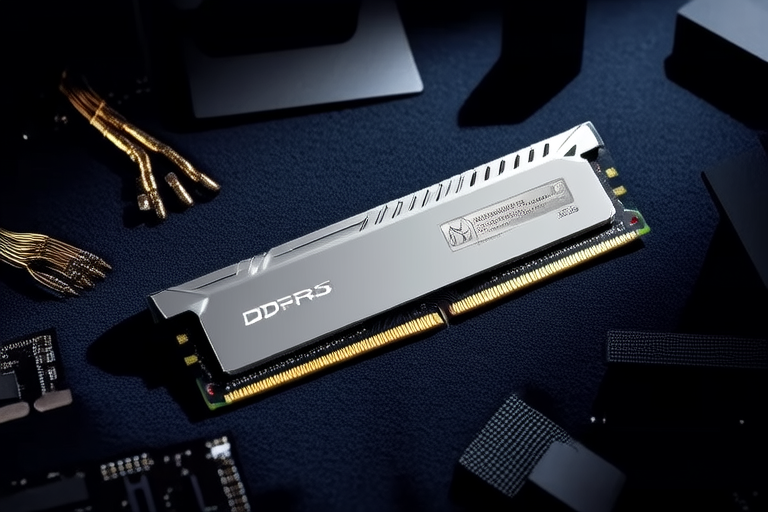“`html
A Deep Dive into DDR5 RAM: What You Need to Know
Introduction
DDR5 RAM, the latest generation of dynamic random-access memory, represents a significant leap forward in performance and efficiency compared to its predecessor, DDR4. Introduced to meet the growing demands of modern computing, DDR5 offers enhanced bandwidth, improved power efficiency, and increased reliability, making it an essential component for next-generation systems.
While DDR4 has served users well for several years, DDR5 introduces several advancements that make it particularly suitable for high-performance applications. These improvements are crucial for tasks that require rapid data processing and efficient energy usage, such as gaming, video editing, and data science.
Key Features of DDR5 RAM
Increased Bandwidth
One of the most notable features of DDR5 RAM is its significantly higher data transfer rates. DDR5 can achieve speeds of up to 8,400 MT/s (Million Transfers per Second), which is double the maximum speed of DDR4. This increased bandwidth translates to faster data access and processing times, leading to smoother multitasking and improved overall system performance.
Improved Power Efficiency
DDR5 RAM operates at lower voltages than DDR4, typically around 1.1V compared to DDR4’s 1.2V. This reduction in voltage leads to better power efficiency, which is particularly beneficial for systems that require extended periods of operation, such as servers and workstations. Additionally, DDR5’s improved thermal efficiency ensures that it remains cooler during intense workloads, reducing the risk of overheating and extending the lifespan of the memory modules.
Enhanced Reliability
DDR5 includes advanced error correction capabilities, such as On-Die ECC (Error-Correcting Code), which helps maintain data integrity even under harsh conditions. This feature is especially important for mission-critical applications where data accuracy is paramount. The improved reliability of DDR5 RAM ensures that systems can operate without errors, even when handling large volumes of data.
Higher Capacity
The maximum capacity per module in DDR5 has also been increased, allowing for larger individual sticks of RAM. DDR5 modules can now reach capacities of up to 64GB, compared to DDR4’s maximum of 32GB. This expanded capacity enables systems to handle more complex tasks and larger datasets, making it ideal for applications like virtualization and cloud computing.
Technical Specifications
DDR5 RAM comes with a range of technical specifications that define its performance and compatibility:
- Clock Speeds: DDR5 operates at higher clock speeds, with standard configurations starting at 4,800 MT/s and reaching up to 8,400 MT/s.
- Voltage Requirements: DDR5 typically requires 1.1V, down from DDR4’s 1.2V, improving power efficiency.
- Module Capacities: DDR5 modules are available in various capacities, including 8GB, 16GB, 32GB, and 64GB.
- Supported Memory Channels: DDR5 supports dual-channel configurations, allowing for two memory modules to be used simultaneously for increased bandwidth.
Compatibility and Upgrade Considerations
Upgrading to DDR5 RAM requires careful consideration of compatibility with existing hardware. While DDR5 is backward compatible with DDR4 in terms of physical design, it is not directly interchangeable due to differences in voltage requirements and interface specifications.
To support DDR5, motherboard manufacturers have introduced new chipsets that are specifically designed for DDR5 RAM. Users will need to ensure that their motherboard and CPU support DDR5 before making the upgrade. Additionally, some systems may require BIOS updates to fully utilize DDR5’s capabilities.
If you’re considering upgrading from DDR4 to DDR5, it’s advisable to consult your system’s documentation or contact the manufacturer for guidance on compatibility and necessary steps.
Applications and Use Cases
Gaming
For gamers, DDR5 RAM offers faster loading times and improved frame rates, enhancing the overall gaming experience. With higher bandwidth, DDR5 allows for smoother gameplay and reduced latency, ensuring that players can react quickly to in-game events.
Video Editing
In video editing, DDR5 RAM’s increased capacity and bandwidth enable editors to work with larger files and multiple streams simultaneously. This capability is particularly useful for professionals who need to handle high-resolution footage and complex effects.
Data Science and Machine Learning
Data scientists and machine learning engineers benefit greatly from DDR5’s enhanced performance. The faster data transfer rates and higher capacity allow for quicker processing of large datasets, accelerating model training and analysis.
Virtualization and Cloud Computing
Virtualization and cloud computing environments demand high-capacity and high-speed memory. DDR5’s ability to handle large amounts of data efficiently makes it ideal for these applications, enabling seamless operation of multiple virtual machines and cloud services.
Future Prospects
The future of DDR5 RAM looks promising, with ongoing research and development aimed at further improving its performance and efficiency. Potential advancements include even higher clock speeds, increased capacities, and enhanced power management techniques.
As technology continues to evolve, we can expect DDR5 to play a pivotal role in driving innovation across various industries. Its ability to meet the demands of next-generation applications will solidify its position as a cornerstone of modern computing.
Conclusion
DDR5 RAM represents a significant advancement in memory technology, offering higher bandwidth, improved power efficiency, and enhanced reliability. Its increased capacity and compatibility with modern systems make it an essential component for high-performance computing. Whether you’re a gamer, video editor, data scientist, or cloud engineer, DDR5 RAM can provide the performance boost you need to stay ahead in today’s competitive environment.
As the industry continues to adopt DDR5, its impact on various sectors will only grow, reinforcing its importance in modern computing. By understanding the benefits and applications of DDR5 RAM, you can make informed decisions about upgrading your systems and optimizing your workflows.
“`


